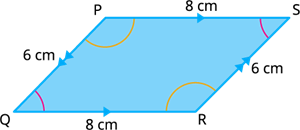PDF chapter test TRY NOW
A parallelogram is a quadrilateral whose opposite sides are parallel and equal.

Here ABCD is a parallelogram.
The side AB is parallel to the side CD and the side AD is parallel to the side BC.
Also, the length AB = CD and AD = BC.
Example:
Consider the parallelogram PQRS with its sides measures 6 cm and 8 cm.

In here the side PQ is parallel to RS and the side PS is parallel to QR.
Also, it is clear that the length PQ = RS = 6 cm and the length PS = QR = 8 cm.
Elements of parallelogram:
Parallelogram is made up of four sides and four angles. There are some terms we usually use to denote parallelogram.
They are:
- Opposite sides
- Opposite angles
- Adjacent sides and
- Adjacent angles.

Let's see the elements of the parallelogram ABCD.
- The side AB is opposite to the side CD and the side AD is opposite to the side BC.
- The angle A is opposite to the angle C and the angle B is opposite to the angle D.
- The side AB is adjacent to the side BC because one of the sides starts where the other ends. In here, the side AB ends at the vertex B and the side BC starts from there.
- The angles A and B are adjacent angles as they are at the ends of the same side AB.
